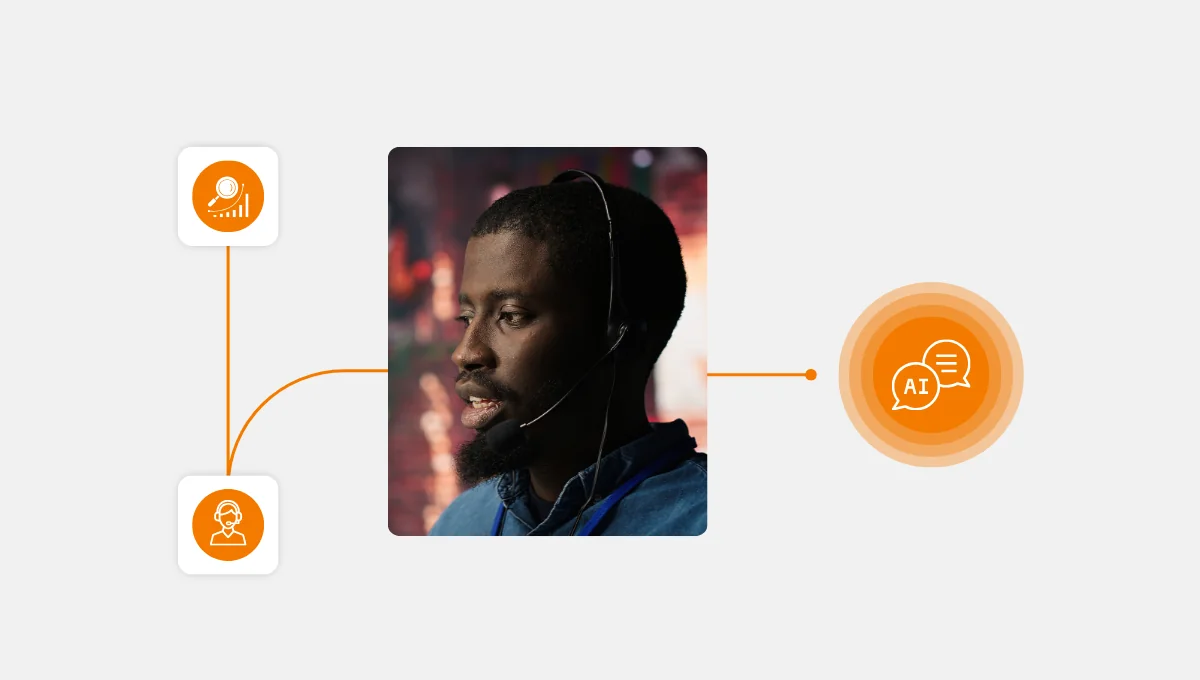Integrating your call center with a CRM is a CX imperative.
Siloed customer data causes friction, frustration, and high churn.
Learn how this essential integration
- eliminates silos,
- empowers agents with a complete 360-degree view, and
- drives superior, personalized service to secure long-term loyalty.
Why integrate your call center with a CRM system?
Failure to integrate customer data inevitably leads to friction, frustration, and customer churn.
Seamless CRM integration is essential because it:
- Eliminates Silos: Moves agents away from separate platforms to a unified service environment.
- Empowers Agents: Provides full historical context and real-time customer data instantly.
- Improves Metrics: Dramatically improves key performance indicators (KPIs), such as response times and First Call Resolution (FCR).
- Elevates Service: Transforms agents from reactive transactors into sophisticated problem-solvers capable of personalized support.
- Ensures Quality: Meets modern customer expectations for instant, informed, and personalized support across all channels.
The CX Imperative: Why Siloed Data Fails the Customer
Modern consumers have set a high bar for service quality, expecting absolute consistency whether they use a phone call, email, or chat.
They expect instant recognition and intensely dislike having to repeat their story, account details, or recent issues. The baseline expectation for customer trust is that the agent will instantly know
- who they are,
- what they bought, and
- their reason for reaching out.
When a contact center is not integrated, agents manually switch between discrete platforms: the contact center tool for the interaction and the CRM for data. This constant context switching
- is highly inefficient,
- interrupts the conversation flow,
- makes the agent seem unprepared.
Every extra step adds precious seconds to the Average Handle Time (AHT). Siloed data creates a disconnected, disjointed experience that directly harms customer satisfaction.
Integration eliminates these roadblocks, establishing a true omnichannel environment where data flows freely. Using Screen Pop functionality, the CRM instantly populates the customer profile when a call arrives. This arms the agent with the complete context needed for efficient resolution.
Real-Time Data: The Engine of Personalized CX
The core of successful CRM integration is creating a true 360-degree customer view, available the moment an interaction begins.
This goes beyond a simple name check, providing granular, actionable details that enable predictive personalization and superior service quality.
Agents instantly access critical information:
- Purchase History: Allows agents to check warranty status and subscription tiers, and to suggest relevant upgrades. So the interaction moves from generic to highly tailored support.
- Service History: A complete chronological record of all previous tickets, resolutions, and notes, crucial for eliminating the “repeat yourself” syndrome and saving time and emotional energy for both parties.
- Customer Sentiment Score: Provided by AI, this offers an ethical warning if the customer has expressed recent dissatisfaction. This allows the agent to approach the interaction with heightened empathy and an immediate de-escalation strategy.
- Lifecycle Stage: Knowing if the customer is a new prospect or a long-term loyalist helps the agent instantly tailor messaging, tone, and offers, maximizing retention and upselling potential.
This instant, comprehensive access allows the agent to skip tedious verification and jump straight to proactive problem-solving.
This dramatically improves resolution speed and quality, transforming reactive service into personalized support, the fastest way to build trust and drive long-term loyalty.
Optimizing Agent Performance Through Unified Workflow Automation
The benefits of integration extend deeply into agent performance and operational efficiency. By streamlining the agent desktop, the system improves service. Plus, the job gets easier, less stressful, and more rewarding for agents, helping reduce turnover and training costs.
A tightly integrated system provides a “single pane of glass” interface.
Agents manage all communication channels (voice, email, chat) and update the CRM record without leaving the single contact center application.
This is facilitated by intelligent workflow automation that automatically performs numerous background tasks:
- Automatic Data Entry: The system instantly creates a new case, ticket, or activity log in the CRM when an interaction starts, ensuring no data is lost or unrecorded.
- Activity Logging: Precise duration, outcome (disposition codes), and agent notes are logged directly into the customer’s CRM record.
- Screen Pop for Guidance: The system can display a dynamically guided script, macro buttons for everyday actions (like issuing a refund), or knowledge base articles specific to the customer’s identified issue.
This significant reduction in manual data entry and context switching directly lowers Average Handle Time (AHT) by up to 20% and significantly boosts First Call Resolution (FCR) rates.
These powerful operational improvements, combined with lower agent burnout, confirm that service quality naturally soars.
The Strategic Impact of Unified Data
The most strategic impact of integration lies in the consolidated data repository, which fuels actionable CX insights and strategic business decision-making.
Every interaction, resolution, complaint, and feedback point is logged accurately and systematically in the CRM.
When call center data is systematically tagged and deposited into the CRM, management can leverage advanced analytics to inform crucial strategic business decisions:
- Identify Root Causes: Pinpoint recurring product or service issues based on the volume and nature of support tickets. This provides precise data for R&D to fix problems upstream, significantly reducing future call volume and saving costs.
- Forecast Demand: Accurately predict seasonal spikes or post-campaign support load, allowing proactive agent scheduling and resource allocation to prevent long customer wait times.
- Analyze Agent Performance: Correlate service metrics (AHT, FCR, quality scores) directly with customer satisfaction scores (CSAT/NPS) linked to the CRM record. This provides a holistic view of agent effectiveness and training needs.
- Personalize Proactive Outreach: Use data on recent support issues or product usage to fuel highly targeted marketing campaigns, such as offering an extra month of service to an at-risk customer.
This strategic use of unified data is where the system shifts decisively from being perceived as a cost center to a verifiable profitability engine.
Research consistently shows that companies leveraging AI for hyper-personalization across all touchpoints often see a 25% increase in Customer Lifetime Value (CLV).
Key Takeaways
Integrating your contact center software with your CRM is an essential, high-ROI investment that pays dividends in customer satisfaction and business growth.
This integration provides the critical foundation for delivering the personalized, efficient support modern consumers demand.
You can optimize every touchpoint by
- streamlining the agent experience via workflow automation and
- providing a complete, unified view of customer interactions via real-time data.
Start exploring how a platform that supports deep integration. Call Center Studio can transform your operations and secure long-term customer loyalty.






